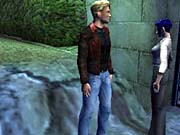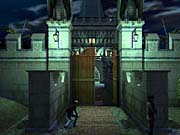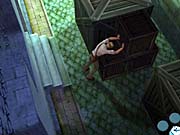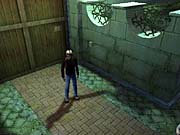Broken Sword: The Sleeping Dragon Preview
We meet with Charles Cecil of Revolution Studios to check out the latest Broken Sword adventure game on the PC, PS2, and Xbox.
At a recent press event in London we met with Charles Cecil of Revolution Studios to check out the upcoming graphical adventure game Broken Sword: The Sleeping Dragon on the PC, PlayStation 2, and Xbox. The versions of the game on display were being shown for the first time and were the first to feature facial animation and voices, which, according to Cecil, had only been implemented late the previous evening.

The first level we were shown was from the PC version of the game--it was the same plane crash in the Congo that we'd seen on previous occasions. This level is from the beginning of the game when the central character, George, who works as a patent lawyer and is en route to a meeting with a scientist, awakens to find that his plane has crashed and is perched precariously atop a large cliff face. George's objective at this point is to get both himself and the unconscious pilot out of the plane safely, and as soon as George began to interact with the other character, we got to see some of the new features that have been implemented since our last look at the game back in April.
George's facial animation is now extremely impressive, and in the areas that his voice had been implemented it was great to see that the lip-syncing held up just as well as his seemingly limitless facial expressions. It was also good to hear that the voice talent being employed for the key characters in The Sleeping Dragon is the same talent that was used for previous Broken Sword games, and Cecil was keen to point out that this will also be true for localized versions of the game where the voice-overs have been recorded in foreign languages by a completely different cast.
Animations have been implemented for the solutions to a number of the object-based puzzles in the game, and you'll also be treated to an animation of some description if you attempt to use the wrong object in a given location, rather than just being told by George that he doesn't think it'll work or being made aware by some other, equally frustrating device that you're wrong. To awaken the unconscious pilot, for example, George needs to use a bottle opener with a bottle of beer, but, since he also has a fire extinguisher concealed on his person, there's no reason why you wouldn't think to use that instead. In this instance the extinguisher is actually empty and is of little use, but because attempting to use it is logical, Cecil has seen fit to include an animation of George trying and failing to squirt water into the pilot's face.
These kinds of error animations will, according to Cecil, be included for any such situations that he considers to be logical and justifiable attempts at solving a puzzle, but if you attempt something as ridiculous as trying to put out a fire with a bottle opener, you can expect George to merely shrug his shoulders. A number of cutscenes focusing on the rescue of the pilot and the subsequent demise of the plane have also been implemented since April, and while they were all very short, they did an excellent job of adding a little extra drama to the proceedings through the use of camera angles that would be wholly inappropriate during actual gameplay.
At no point in the game will you be allowed to control the camera yourself, and, while on occasion you might want to look around a little more than the fixed camera allows, we're pleased to report that from what we've seen, the camera will never be something that you feel you have to work against. In fact, most of the camera angles in the game appear to do a very good job of combining interesting and varied visuals with functionality, ensuring that any changes aren't so dramatic that you suddenly find yourself running in the wrong direction.

The next level we were shown was also from the PC version of the game. In it, the characters George and Nico work together in an attempt to infiltrate the Susarro HQ--a large, moonlit castle. In instances where both of the central characters are present, you will always have direct control of George but will also be able to have Nico perform various actions by using her in much the same way you would use an object. When asked, Cecil stated that while he likes his games to be challenging, he'd like to think that almost everyone who plays The Sleeping Dragon will be able to complete the game, and what followed was a great demonstration of how this might be achieved.
Box Clever
In order to gain access to the castle through a large locked gate, George can have Nico ring the doorbell and then distract the guard that greets her, thus giving George a few seconds to slip by unnoticed. This particular puzzle requires you to be able to move George quickly and accurately, and it was good to see that rather than punishing you for getting caught in the act, the game essentially makes the whole process a little easier for you the next time around. The second time Nico knocks on the gate she'll behave a little more amorously toward the guard who answers, giving George a few extra seconds to pass unnoticed, and should a third attempt prove necessary, we were told that Nico will kiss the guard in question and make it even easier for George to get into the castle successfully--all of which is in keeping with Cecil's thinking that the challenge in the Broken Sword games should be in working out what you have to do rather than in actually doing it.

A number of the puzzles that we got to see in The Sleeping Dragon involved George or Nico manipulating boxes or crates in some way, whether by sliding them around to create steps to scale a wall or by merely dragging one onto a pressure pad on the floor to keep a door open. We were told that boxes won't be playing as large a part in the game as they did in our demonstration, but, as Cecil pointed out, they do make for some exceedingly good puzzles. They also proved to be a good vehicle for Cecil to demonstrate some of the characters' impressive animations when interacting with objects.
We then turned our attention to the Xbox version of the game, and Cecil showed us the same scene of Nico arriving at her friend's apartment in Paris that we'd seen on the PC earlier this year. The Xbox version looks just as impressive as its PC counterpart, and we saw a number of new animations as Nico climbed over balcony railings, hung from a roof, and shimmied from one balcony to another demonstrating strength and agility worthy of Lara Croft. When Nico entered the friend's apartment, we noticed a subtle change in the mood of the musical score that hinted at danger ahead, and sure enough, it wasn't long before we were confronted by another female character brandishing a gun. Up to that point the game's soundtrack, although pleasing to the ears, had more or less gone unnoticed, but it performed its function admirably as it subtly warned us of an unseen danger in exactly the same way movie scores do.
For the final part of our demonstration, Cecil moved to the PS2 version of the game and to a level in which Nico arrives in the streets of Paris by taxi before attempting to gain entry into a large building. This level basically involved negotiating numerous platforms and ladders on scaffolding on the building's exterior, and while all of the actions to make jumps and to climb on or off ladders were performed with the push of a single button, the area was challenging in much the same way a maze is, thanks to some unusual layouts and camera angles.

Broken Sword: The Sleeping Dragon is currently scheduled for release in October, and it looks to be progressing nicely. Features such as the in-game hints system and pop-up windows on the first level to help you get accustomed to the controls have yet to be implemented, but as the most visually impressive and lengthiest game in the series to date, it seems to be shaping up well. The only thing Revolution really needs to work on now is a substitute for the placeholder blue sparkle effects that currently highlight useful objects whenever you enter a new location in the game--a puzzle that Cecil and his team will solve quickly enough.
Got a news tip or want to contact us directly? Email news@gamespot.com
Join the conversation